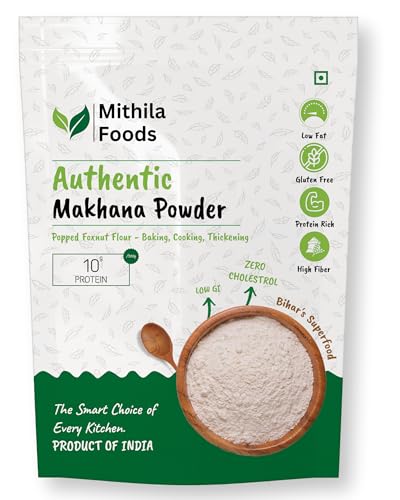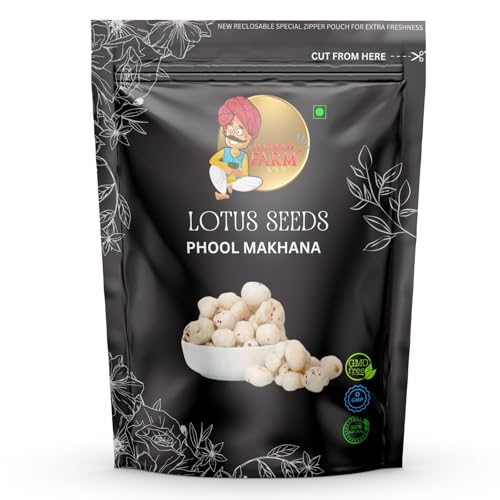Makhana, also known as fox nuts or lotus seeds, have been a staple in traditional Asian diets for centuries, particularly in India where they’re revered as a fasting food. In recent years, they have emerged on the global stage as a healthy, gluten-free snack. They are praised for their nutritional benefits, including a low-calorie count, high fiber content, and a rich profile of minerals. But is makhana truly a superfood for everyone? While they offer a wide array of health advantages, certain individuals should exercise caution or avoid them altogether.
This comprehensive guide delves deep into the world of makhana, exploring its nutritional profile, its proven health benefits, and, most importantly, identifying who can benefit the most and who needs to be cautious. We’ll go beyond the surface-level information to provide a nuanced, in-depth look at this popular snack, empowering you to make an informed decision for your health.
Table of Contents
Understanding the Nutritional Powerhouse: What Makes Makhana So Healthy?
To truly appreciate the benefits and potential risks of makhana, it’s essential to understand its nutritional composition. A 100-gram serving of makhana is a treasure trove of essential nutrients while being remarkably low in fat and calories.
- Low in Saturated Fat and Cholesterol: With a minimal fat content of about 0.1g per 100g, makhana is a heart-friendly snack that helps manage cholesterol levels and reduce the risk of cardiovascular diseases.
- High in Fiber: Makhana is a great source of dietary fiber, which is crucial for digestive health. A 100-gram serving can contain as much as 14.5g of fiber, which helps promote regular bowel movements, prevent constipation, and keep you feeling full for longer.
- Rich in Minerals: Makhana is packed with vital minerals such as calcium, magnesium, potassium, and phosphorus. These minerals play a crucial role in maintaining strong bones, regulating blood pressure, and supporting overall bodily functions.
- Plant-Based Protein: While not as protein-dense as some nuts, makhana provides a decent amount of plant-based protein (about 9.7g per 100g). This makes it a great snack option for vegetarians and vegans.
- Antioxidants: Makhana is rich in powerful antioxidants like kaempferol and quercetin. These compounds help combat oxidative stress, reduce inflammation, and protect cells from damage caused by free radicals.
- Low Glycemic Index (GI): With a low glycemic index, makhana prevents rapid spikes in blood sugar levels, making it a safe and beneficial snack for those managing blood sugar.
This impressive nutritional profile is why makhana is often recommended by health experts and dietitians as a wholesome and guilt-free snack.
Who Should Eat Makhana? The Ideal Candidates for This Superfood
Makhana offers a wide range of benefits for many people, making it an excellent addition to a balanced diet. Here’s a detailed breakdown of the individuals who can benefit most from consuming makhana.
1. People Managing Diabetes
For those with diabetes, finding a healthy snack that doesn’t cause blood sugar spikes is a constant challenge. Makhana is an excellent choice due to its low glycemic index (GI). The GI of makhana is around 22, which is significantly lower than many common snacks. This low GI means that carbohydrates in makhana are digested and absorbed slowly, leading to a gradual release of glucose into the bloodstream.
Furthermore, its high fiber and protein content contribute to better glycemic control by slowing down sugar absorption and promoting insulin sensitivity. Regular consumption in moderation can help stabilize blood sugar levels and prevent sudden fluctuations.
2. Individuals Aiming for Weight Management
Makhana is a perfect snack for weight loss because of its unique combination of low calories and high fiber. A serving of roasted makhana is low in calories, making it a satiating snack that won’t derail your diet. The high fiber content promotes a feeling of fullness, which helps curb appetite and reduces the urge to snack on unhealthy, high-fat foods. Swapping out traditional junk food like chips and crackers for roasted makhana can significantly reduce calorie and saturated fat intake, contributing to healthy weight loss.
3. Those with Heart Concerns
Makhana is a heart-friendly snack, especially for individuals concerned about high blood pressure and cholesterol.
- Regulates Blood Pressure: It is naturally low in sodium and rich in magnesium and potassium. These minerals are crucial for regulating blood pressure. Potassium helps balance out sodium levels in the body, while magnesium helps relax blood vessels, promoting better blood circulation and reducing strain on the cardiovascular system.
- Lowers Cholesterol: The low saturated fat and cholesterol content of makhana, combined with its fiber, can help reduce “bad” cholesterol (LDL) levels while increasing “good” cholesterol (HDL). The antioxidants in makhana also help protect against oxidative stress and inflammation, which are major risk factors for heart disease.
4. Pregnant Women
Makhana is considered a safe and highly beneficial snack for pregnant women when consumed in moderation. Its rich nutrient profile is essential for both the mother and the developing fetus.
- Folate and Calcium: Makhana is a good source of folate, which is vital for the proper development of the fetal brain and spinal cord. Its high calcium content is crucial for the formation of strong bones and teeth in the baby and for maintaining the mother’s bone density.
- Aids Digestion and Provides Energy: Constipation and fatigue are common during pregnancy. The fiber in makhana helps with digestion and regular bowel movements, while the complex carbohydrates provide a sustained energy release.
- Manages Gestational Diabetes: For pregnant women at risk of or with gestational diabetes, makhana’s low GI can help in managing blood sugar levels.
However, pregnant women should always consult their doctor or nutritionist before making any significant changes to their diet.
5. People with Digestive Issues (in moderation)
Makhana is a light and easily digestible food. For people with minor digestive issues or those prone to constipation, the high fiber content can promote regularity. It is also gluten-free, making it an excellent snack for those with gluten intolerance or celiac disease.
6. Vegans and Vegetarians
As a plant-based food, makhana is a great source of protein and essential minerals for people following a vegan or vegetarian diet. It’s a versatile ingredient that can be roasted as a snack, added to curries, or used in desserts to enhance nutritional value.
Who Should Be Cautious with Makhana? The Potential Risks and Side Effects
While makhana is a nutritional powerhouse for many, it is not suitable for everyone. Certain medical conditions and individual sensitivities may require individuals to limit or completely avoid its consumption. Understanding these risks is crucial for making a healthy choice.
1. Individuals with Kidney Stones or a Predisposition
Makhana contains oxalates, which are naturally occurring compounds that can bind with calcium and other minerals in the urine to form crystals. In individuals with a history of or predisposition to kidney stones, a high intake of oxalate-rich foods can increase the risk of stone formation. While makhana’s oxalate content is moderate, people with this condition should limit their consumption and stay well-hydrated.
2. People on Blood-Thinning Medications
Makhana contains a moderate amount of Vitamin K, a nutrient that plays a crucial role in blood clotting. For individuals on blood-thinning medications like warfarin, a sudden or excessive increase in Vitamin K intake can interfere with the medication’s effectiveness. It’s essential to maintain a consistent Vitamin K intake, and therefore, people on such medications should consult a healthcare provider before regularly incorporating makhana into their diet.
3. People with Severe Digestive Disorders
While makhana’s high fiber is beneficial for many, it can be problematic for those with severe digestive disorders such as Irritable Bowel Syndrome (IBS) or Inflammatory Bowel Disease (IBD). The high fiber content may be difficult for a compromised digestive system to process, potentially leading to increased symptoms like bloating, gas, and abdominal discomfort.
4. People with Gout or High Uric Acid Levels
Makhana contains purines, which are organic compounds that can break down to form uric acid in the body. For individuals with gout or high uric acid levels, excessive purine intake can worsen symptoms and increase the risk of painful gout attacks. Moderation is key, and it is advisable to consult a doctor to determine a safe amount.
5. Individuals with Allergies
Though rare, some people may have an allergic reaction to makhana. Symptoms can range from mild itching and hives to severe anaphylaxis. Individuals with known allergies to nuts and seeds should introduce makhana gradually and be mindful of any adverse reactions.
6. The Risk of Overconsumption
Even for healthy individuals, excessive consumption of makhana can lead to side effects. The high fiber content, if not accompanied by sufficient water intake, can cause bloating and constipation. Additionally, while makhana is low in calories, roasting it with excessive ghee, oil, or sugar can make it calorie-dense, potentially leading to weight gain. As with any food, moderation is the key to reaping its benefits without experiencing negative side effects.
In-Depth Analysis: The Scientific Backing Behind Makhana’s Claims
The growing popularity of makhana is not just a trend; it’s backed by a body of scientific understanding that supports its traditional use. We’ll explore some of the key mechanisms through which makhana impacts the body.
The Glycemic Response and Insulin Sensitivity
The low glycemic index of makhana is a significant factor in its health benefits, particularly for blood sugar management. When you consume a food with a high GI, like a white bread, the glucose is released quickly into your bloodstream, causing a rapid spike in blood sugar. This prompts the pancreas to release a large amount of insulin to bring the sugar levels down. Over time, this repeated demand can lead to insulin resistance.
Makhana’s low GI ensures a slow, steady release of energy. The fiber in makhana forms a gel-like substance in the digestive tract, which physically slows down the absorption of glucose. This allows the body to manage blood sugar levels more effectively, reducing the strain on the pancreas and improving insulin sensitivity over the long term.
Cardiovascular Health: The Role of Magnesium and Potassium
Makhana’s impact on heart health can be directly attributed to its mineral content. Magnesium acts as a natural calcium channel blocker, helping to relax and widen blood vessels. This relaxation reduces resistance to blood flow, thereby lowering blood pressure. Potassium, on the other hand, works to counteract the effects of sodium. High sodium intake leads to water retention and increased blood volume, which raises blood pressure. Potassium helps the kidneys excrete excess sodium, which helps to lower blood pressure.
The presence of these two minerals in makhana makes it a powerful dietary component for maintaining cardiovascular wellness.
Antioxidants and Anti-Inflammatory Properties
Chronic inflammation is a silent contributor to many diseases, including heart disease, arthritis, and some cancers. The antioxidants in makhana, such as flavonoids and phenolic acids, help neutralize free radicals that cause oxidative stress and cellular damage. This anti-inflammatory action is crucial for protecting the body at a cellular level, reducing the risk of various chronic diseases.
The anti-inflammatory effects of makhana are particularly beneficial for those with inflammatory conditions, but they can provide a general protective effect for everyone, contributing to a longer, healthier life.
Practical Guide to Consuming Makhana: Recipes and Tips
The best way to enjoy the benefits of makhana is to incorporate it into your diet mindfully. Here are some simple and delicious ways to eat makhana.
The Classic Roasted Makhana Snack
This is the most popular way to consume makhana.
- Dry roast the makhana in a pan over low to medium heat until they become crunchy.
- Add a teaspoon of ghee or a light drizzle of oil.
- Add seasonings of your choice. A simple and healthy option is a pinch of black salt and black pepper. For more flavor, you can use turmeric, chili powder, or chaat masala.
- Store in an airtight container to maintain freshness.
Creative Ways to Use Makhana
- Makhana Kheer: A traditional Indian dessert where makhana is boiled in milk and sweetened. It’s a healthier alternative to rice pudding.
- Makhana Curry: Add roasted makhana to vegetable curries for a unique texture and a boost of nutrients.
- Smoothie Topping: Sprinkle crushed roasted makhana on top of your smoothies or yogurt for a satisfying crunch.
- Salad Crunch: Use roasted makhana as a gluten-free crouton alternative in your salads.
First-Hand Experience: My Journey with Makhana
For years, I struggled to find a healthy, satiating snack that would keep my energy levels stable without causing me to crash. My diet consisted of processed foods and high-sugar snacks, which left me feeling sluggish and unfocused. A friend suggested I try makhana as an alternative.
At first, I was skeptical. The idea of “fox nuts” didn’t sound particularly appealing. However, I decided to give them a try, starting with a small bag of plain, roasted makhana. The first thing that struck me was their light, airy texture and subtle, nutty flavor. They were surprisingly filling and curbed my mid-afterning cravings for junk food.
Over time, I experimented with different seasonings and recipes. I found that a simple sprinkle of black pepper and a touch of Himalayan salt was my favorite way to enjoy them. I also started adding them to my breakfast cereal and evening tea. After a few weeks, I noticed a significant difference in my energy levels. The afternoon slumps were gone, and I felt more alert and productive throughout the day. This simple change not only improved my diet but also had a positive impact on my overall well-being.
This experience taught me that small dietary changes can lead to big health benefits. It’s not about a complete overhaul but about making smart, sustainable swaps that work for your lifestyle. Makhana became my go-to snack, and I’ve been recommending it to friends and family ever since.
Frequently Asked Questions (FAQ)
1. How much makhana should I eat per day?
Moderation is key. A safe daily serving is typically around 30 grams (a handful of roasted makhana). Eating more than this can lead to excessive carbohydrate or fiber intake, which may cause digestive discomfort.
2. Can I eat makhana raw?
While makhana seeds can be eaten raw, they are best consumed after roasting. Roasting them makes them crunchy and enhances their flavor, making them more enjoyable as a snack.
3. Is makhana good for children?
Yes, makhana is an excellent and safe snack for children. Its nutrient density, including calcium and protein, supports healthy bone development and provides sustained energy. However, ensure that the makhana is not a choking hazard for young children.
4. Does makhana help with insomnia?
Makhana is believed to have calming properties. The magnesium in makhana plays a role in regulating the nervous system and promoting relaxation, which can help improve sleep quality.
5. Is makhana a nut?
Despite being called “fox nuts” or “lotus nuts,” makhana is not a true nut. It is a seed derived from the Euryale ferox plant. This makes it a great alternative for those with nut allergies.
Conclusion: A Final Word on Makhana
Makhana is more than just a passing health food trend; it is a nutrient-dense powerhouse with a rich history and a wide range of proven health benefits. For the vast majority of people, it is a wholesome and safe snack that can support everything from weight management and heart health to blood sugar control.
However, its unique composition means that it is not a one-size-fits-all solution. Individuals with a history of kidney stones, those on certain medications, or people with severe digestive issues should exercise caution and consult with a healthcare professional before making makhana a regular part of their diet.
By understanding who should and shouldn’t eat makhana, and by consuming it in moderation, you can unlock its full potential as a valuable component of a healthy, balanced lifestyle. The key is to listen to your body and make choices that are right for your individual health needs.




